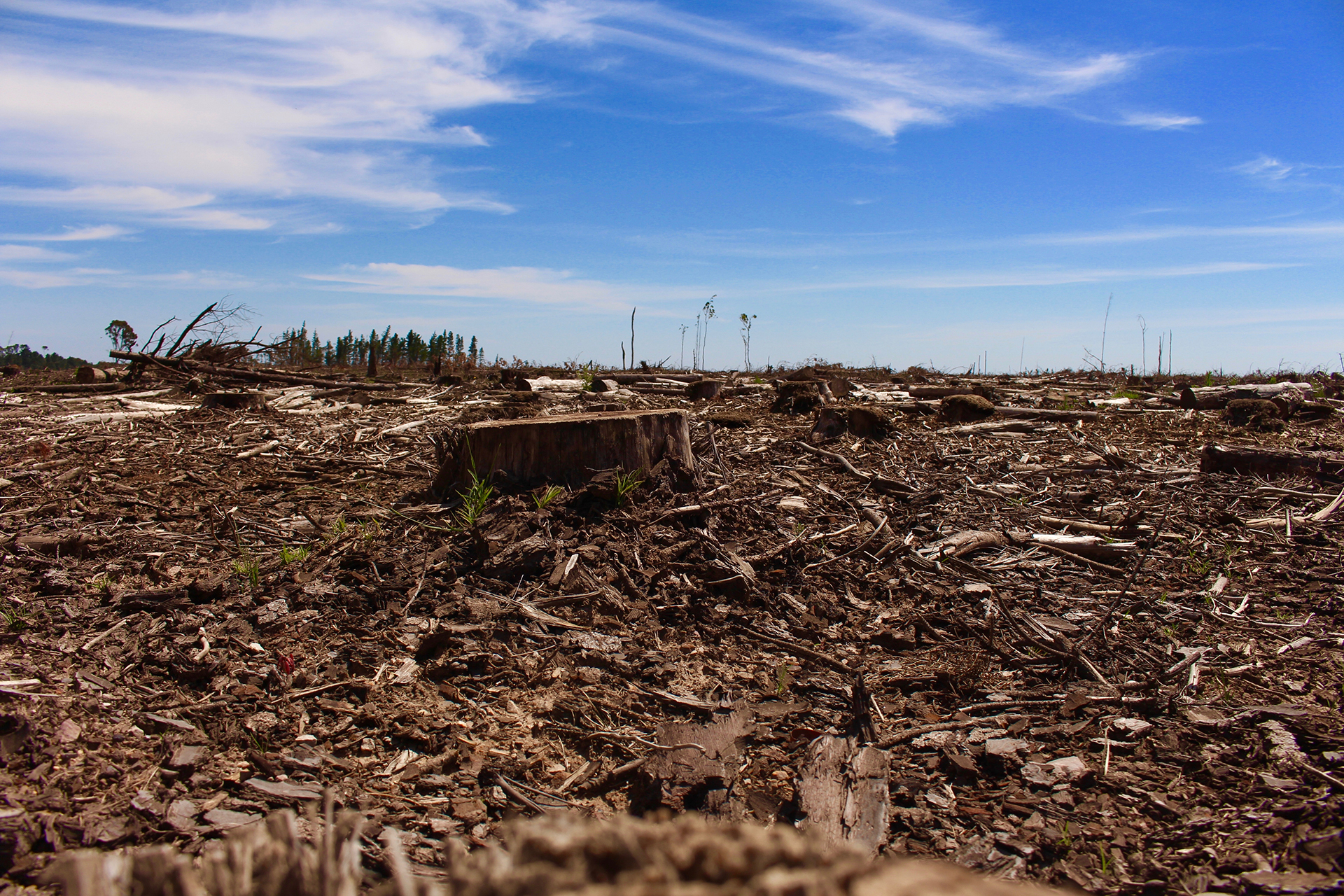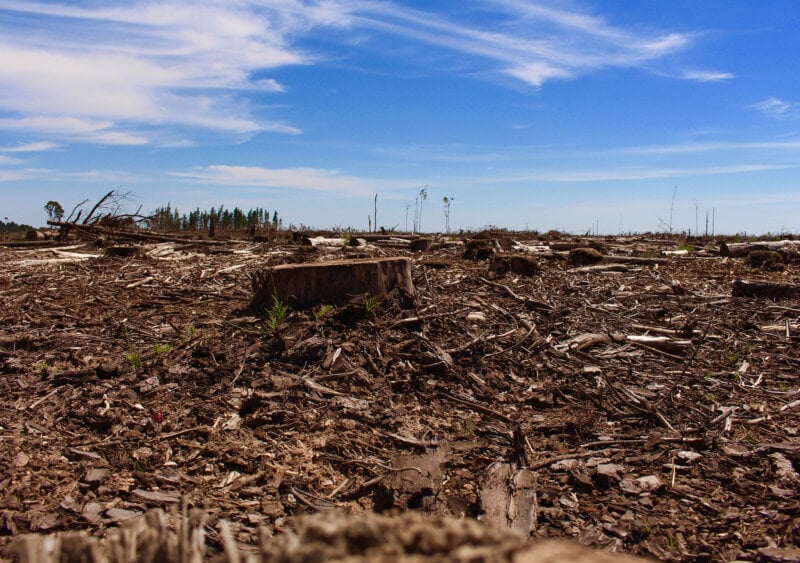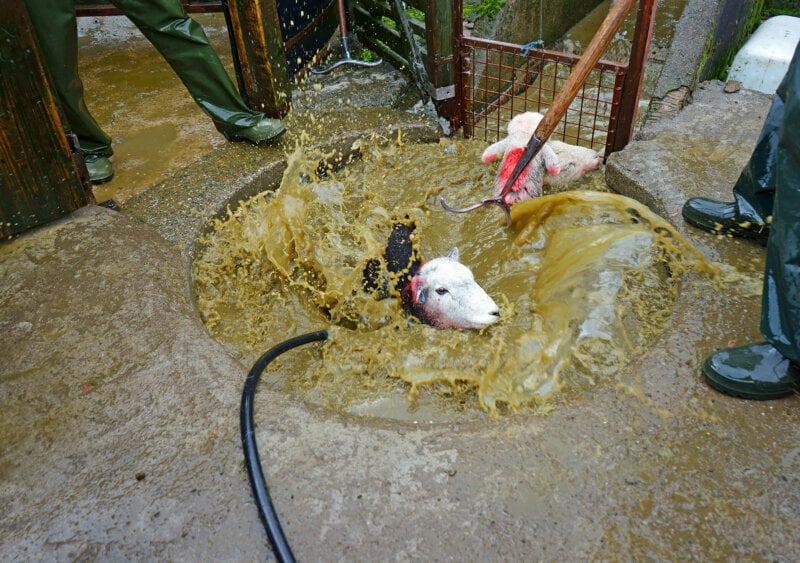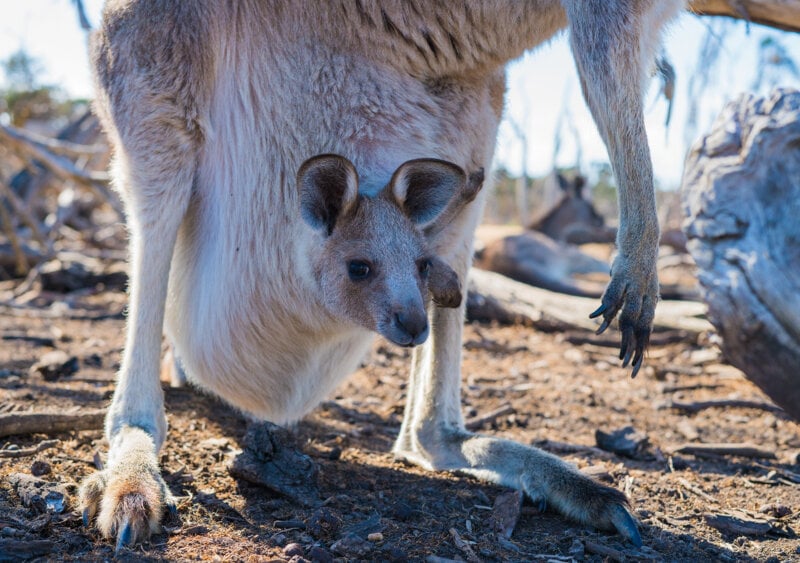Land Clearing
The majority of the world’s wool comes from Australia, but despite the old saying that Australia “rides on the sheep’s back”, sheep aren’t native to the country.
Sheep were introduced with the English invasion, and their numbers grew quickly, Sheep were introduced with the English invasion, and their numbers grew quickly, peaking at around 180 million in the 1970s. Land clearing for pasture was completely unregulated and, at times, was encouraged by the government. In the 19th century, Australian states started passing laws that forced landholders to clear land, and government incentives for clearing land continued through to the 1980s.
Fast-forward to 2021, and Australia is the only developed nation on the list of the world’s deforestation hotspots, compiled by the WWF. Animal agriculture is still the main driver of the clearing, with sheep farming second only to cattle farming in terms of impact.
In an interview with the ABC, WWF conservation biologist Dr Martin Taylor said that people don’t think about agricultural clearing, because it’s hidden from view.
“Eighty-five per cent of it [land clearing] is just for beef cattle pasture or for sheep pasture.”
Animals used in agriculture take up 27% of the Earth’s surface area.
“People do see their local favourite patch of bush being bulldozed for a housing or industrial estate, or a road… That turns out to be a small percentage of the total destruction in Eastern Australia,” he said. “Most of it is out bush, far from the public gaze, and most people don’t know it’s going on.”
He also noted, “Eighty-five per cent of it is just for beef cattle pasture or for sheep pasture.”
There are also government reports that back up the WWF’s findings. In 2020, the New South Wales government commissioned a report which found that “thinning for pasture expansion” is putting biodiversity at risk. Meanwhile, in Queensland, the government’s report “Land Cover Change in Queensland: Statewide Landcover and Trees Study Summary Report: 2016–17 and 2017–18” found that over 90% of the clearing recorded between 2016 and 2018 was for “pasture”.
And while Australia might be one of the worst culprits of land clearing in the world, it certainly isn’t alone. A flight over New Zealand reveals the agricultural impact there, with pasture for sheep used for wool and cows used for dairy taking up huge swathes of the landscape where native forests once were. Meanwhile, it’s been widely publicised that demand for beef is clearing the Amazon rainforest.
Globally, animals used in agriculture take up 27% of the Earth’s surface area, including grazing land and crops grown to feed them. On the other hand, cropland used to feed and clothe humans takes up just 7%.
Systems of production – be it food or clothing – that use animals simply take up a lot of space.
Why Is Land Clearing Bad?
Land clearing and, ultimately, habitat loss are the biggest drivers of species extinction.
In Australia, 34 mammals have gone extinct since European colonisation and more than 1,700 others are now threatened or endangered. No other country has seen so many mammals go extinct.
Tree clearing in Queensland alone is estimated to kill 34 million animals each year, including 900,000 mammals, 2.6 million birds, and 30.6 million reptiles.
One of Australia’s most iconic animals, the koala, was officially listed as “endangered” by the Australian government in 2022. A 2020 parliamentary enquiry in New South Wales found koalas will go extinct in the state by 2050 without prompt intervention to protect their habitat.

In late 2020, politicians in New South Wales battled over a piece of legislation that focused on koala habitat, and the leader of the National Party argued that making it more difficult to clear land would be a “nail in the coffin” for farmers.
The government has now agreed to the new rules, but most private rural land – or farmland – is exempt, a move which the Nature Conservation Council said was like signing a death warrant for koalas.
This is the case all over the world: native species are being sacrificed to make way for domesticated animals deemed “productive” by humans.
Trees and the Climate
Land clearing also affects the climate and can change rainfall by altering the circulation of heat and moisture. Crops and pasture have 70% of their roots in the top 30 cm of the soil, while trees are much more deeply rooted. This means trees can access moisture deep within the soil and evaporate more water above the ground, creating moist, unstable layers in the lower atmosphere. This has the immediate effect of reducing temperatures (have you ever walked into a forest and felt the air was immediately cooler?) and also supports cloud formation and increases rainfall.

Clearing native vegetation diminishes this process and ultimately contributes to a drier, warmer climate.
Soil Degradation
Given the differences in root systems between pasture and forest, it’s easy to see how land clearing leads to an increase in erosion – there are fewer deep-rooted plants to hold the landscape together. In “grass-fed” or “pasture-raised” animal agriculture systems, the grass is repeatedly removed from the soil as the animals continually feed. The impact of the animals’ hooves also compacts the soil, which reduces the downward growth of roots. Some farmers rotate animals into different areas of land in an effort to combat this effect, yet according to the Food and Agriculture Organization of the United Nations, 20% of pastureland worldwide is considered degraded because of overgrazing, compaction, and erosion.
In the first half of the 20th century, Argentina was second only to Australia in wool production. But as Argentinean sheep farmers ramped up production and increased the numbers of animals they kept, the scale of their operations outgrew the capacity of the land to sustain them. Soil erosion in the region has triggered a desertification process that officials estimate threatens as much as 93% of the land. Scientists deem that around 12% of Patagonia – some 10 million hectares – has now passed the point of no return and will never recover.
Emissions
Forests are a natural carbon sink, and the carbon stored in vegetation and soils is vulnerable to return to the atmosphere via land clearing.








